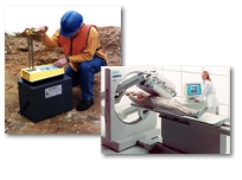
Uranium Recovery
- Virginia Uranium Working Group (NRC participation)
- Operating Uranium Recovery Facilities
- Uranium Recovery Sites Undergoing Decommissioning
- Outreach Strategy for Indian Tribes Potentially Affected by Uranium Recovery Sites
- Uranium Recovery Workshops
Status of Uranium Recovery Facility Applications, Reviews, and Letters of Intent
Dataset | Data Dictionary
What We Regulate
As the precursor to the nuclear fuel cycle, uranium recovery focuses on extracting (or mining) natural uranium ore from the Earth and concentrating (or milling) that ore. These recovery operations produce a product, called "yellowcake," which is then transported to a fuel cycle facility. There, the yellowcake is transformed into fuel for nuclear power reactors. In addition to yellowcake, uranium recovery operations generate waste products, called byproduct materials, that contain low levels of radioactivity.
For mining activities, the regulatory responsibility depends on the extraction method that the given facility uses. Specifically, conventional mining (where uranium ore is removed from deep underground shafts or shallow open pits) is regulated by the Office of Surface Mining, the U.S. Department of the Interior, and the individual States where the mines are located. By contrast, the U.S. Nuclear Regulatory Commission (NRC) regulates in situ recovery (formerly known as in situ leach recovery), where the uranium ore is chemically altered underground before being pumped to the surface for further processing.
The distinction between these regulatory responsibilities is that the NRC becomes involved in uranium recovery operations when the ore is processed and chemically altered. This happens either in a uranium mill (the next step in processing ore from a conventional mine) or during in situ recovery (ISR). For that reason, the NRC regulates in situ recovery facilities (as stated above), as well as uranium mills and the disposal of liquid and solid wastes from uranium recovery operations (including mill tailings). Currently, the NRC regulates active uranium recovery operations in Wyoming, New Mexico, and Nebraska. However, the NRC does not directly regulate the active uranium recovery operations in Texas, Colorado, and Utah, as they are Agreement States, meaning that they have entered into strict agreements with the NRC to exercise regulatory authority over this type of material.
For additional information about what the NRC regulates in relation to uranium recovery, see Operating Uranium Recovery Facilities; License Applications for New Uranium Recovery Facilities, Expansions, Restarts, and Renewals; Sites Undergoing Decommissioning; and the following related pages:
How We Regulate
In accordance with its mission, the NRC focuses its regulatory actions on protecting the health and safety of the public and the environment during the active life of a uranium recovery operation and after the facility has been decommissioned. The NRC staff accomplishes this mission by performing the following activities:
- Develop regulations and guidance for the regulated community.
- Review license applications and amendments.
- Develop environmental assessments (EAs) and environmental impact statements (EISs) to support the agency’s reviews.
- Inspect uranium recovery facilities.
- Review decommissioning plans and activities.
Uranium milling and disposal of the resulting waste byproduct material by NRC licensees are regulated under Title 10, Part 20, of the Code of Federal Regulations (10 CFR Part 20), "Standards for Protection Against Radiation"; 10 CFR Part 40, "Domestic Licensing of Source Material"; and Appendix A to 10 CFR Part 40. As its title implies, Appendix A sets forth the criteria relating to the operation of uranium mills and the disposition of tailings or wastes produced by the extraction or concentration of source material from ores processed primarily for their source material content. In general, these criteria require uranium recovery facilities to control industrial hazards and address waste and decommissioning concerns.
In general, the primary industrial hazards associated with uranium milling are the occupational hazards found in any metal milling operation that uses chemical extraction, as well as the chemical toxicity of the uranium itself. Because the uranium produced at these facilities is not enriched, there is no criticality hazard and little fire or explosive hazard. Radiological hazards are also low at these facilities, as uranium has little penetrating radiation and only moderate non-penetrating radiation. The primary radiological hazard is attributable to the presence of radium in the waste byproduct material (known as "mill tailings"). For additional information, see Uranium Mill Tailings and the Backgrounder on Uranium Mill Tailings.
For additional information about how we regulate uranium recovery operations, see the following related pages:
- Regulations, Guidance, and Communications
- License Applications for New Uranium Recovery Facilities, Expansions, Restarts, and Renewals
- Generic Environmental Impact Statement for In Situ Leach Uranium Milling Facilities
- Oversight of Licensed Uranium Recovery Operations
- Public Involvement
- Hearing Opportunities and License Applications

